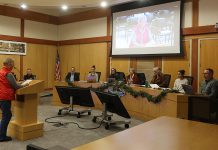Not long ago, Healdsburg’s Memorial Bridge was facing possible
demolition but was saved when the city chose to rehabilitate the
90-year-old community landmark. And just last week, the bridge won
listing in the National Register of Historic Places.
“I am overjoyed and delighted that the bridge got listed,” said
David Dietz, a member of the group Friends of Healdsburg Memorial
Bridge, who took it upon himself to do the legwork for the
recognition.
The Healdsburg bridge joins three other local landmarks on the
federal list — the Healdsburg Carnegie Library (that houses the
museum), Madrona Manor and Hop Kiln Winery.
Because the bridge was already considered eligible for the list,
the city plans and environmental studies had taken the historic
nature of the bridge into account.
“When we started this whole process, we understood it to be
eligible so we treated it the same,” said Healdsburg Public Works
Director Mike Kirn.
“Everything that we have done to date, we’ve recognized and
acknowledged it.”
In September, the city council voted to move forward with plans
to preserve and rehabilitate the bridge, rather than one of the
other eight alternatives, including replacing it with a concrete
structure or converting it into a bike and pedestrian pathway while
building a new crossing alongside.
Healdsburg resident and Memorial Bridge advocate Mel Amato said
he was very pleased with the new historic listing for the
bridge.
“For a long time, it’s been listed as being eligible for
listing, and it was David Dietz’s initiative to proceed with the
application,” Amato. “It’s a good thing to recognize the rarity of
this icon that we enjoy in our city and it’s good that it was
formally announced.”
Dietz said the application for the listing took him about a
month to complete and included a lot of research on the history of
the bridge.
“The application extolled the bridge’s imprint in the city’s
history and its contribution to the development of the region from
the early days of the automobile,” he said. It also emphasized that
the bridge, of an architectural style known as Pennsylvania petite,
is one of only a few of its kind still carrying vehicles in the
U.S., according to Dietz.
“I think it’s certainly important to the community in the sense
that the federal government has recognized the importance of that
bridge to the community,” Dietz said. “I believed in saving the
bridge. I thought it would be sacrilege to take the bridge out
given its meaning to the town, its architectural structure and its
contribution to the development of the region.”
Kirn said environmental studies are ongoing and will likely be
back before the council in the early part of next year.
Upgrading of the bridge, including a new deck and river
footings, will cost an estimated $17.3 million. The city will spend
$2.3 million on the environmental and design process, 88 percent of
which is paid for through grant funds and the remaining 12 percent
funded through Proposition 1B funds and street impact fees.








